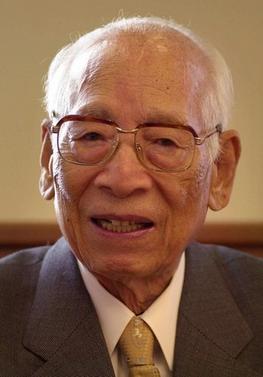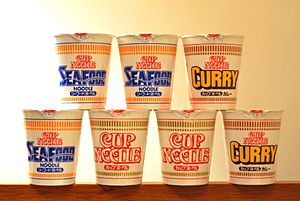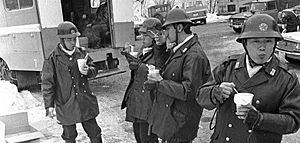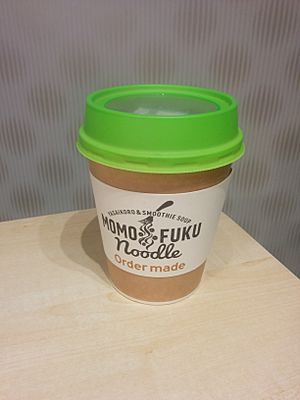Momofuku Ando facts for kids
Quick facts for kids
Momofuku Ando
|
|||||||||||||||
|---|---|---|---|---|---|---|---|---|---|---|---|---|---|---|---|
 |
|||||||||||||||
| Born |
Go Peh-hok (吳百福)
March 5, 1910 |
||||||||||||||
| Died | January 5, 2007 (aged 96) Ikeda, Osaka Prefecture, Japan
|
||||||||||||||
| Citizenship | Japan (1910–1945; 1966–2007) Republic of China (after 1945) |
||||||||||||||
| Alma mater | Ritsumeikan University | ||||||||||||||
| Known for | The invention of instant noodles Founder of the Nissin Food Products Co., Ltd. |
||||||||||||||
| Spouse(s) | Masako Ando | ||||||||||||||
| Children | Hirotoshi Ando Koki Ando Akemi Horinouchi |
||||||||||||||
| Chinese name | |||||||||||||||
| Traditional Chinese | 吳百福 | ||||||||||||||
| Simplified Chinese | 吴百福 | ||||||||||||||
|
|||||||||||||||
| Japanese name | |||||||||||||||
| Kanji | 安藤 百福 | ||||||||||||||
| Hiragana | あんどう ももふく | ||||||||||||||
| Katakana | アンドウ モモフク | ||||||||||||||
|
|||||||||||||||
Momofuku Ando (Japanese: 安藤 百福, Hepburn: Andō Momofuku, born Go Pek-Hok; Chinese: 吳百福; Pe̍h-ōe-jī: Gô͘ Pek-hok; March 5, 1910 – January 5, 2007), was a clever inventor and businessman. He started the company Nissin Food Products Co., Ltd.. He is famous for inventing instant noodles (also known as ramen noodles). He also created the popular brands Top Ramen and Cup Noodles.
Contents
Early Life and Learning
Momofuku Ando was born as Go Pek-Hok in 1910. This was in Chiayi County, Taiwan, when Japan ruled the island. He came from a well-off family. Sadly, his parents passed away, so his grandparents raised him in Tainan.
His grandparents owned a small fabric shop. This inspired him to start his own fabric company at age 22. He used a large sum of money, 190,000 yuan, to begin his business in Taipei.
In 1933, Ando moved to Osaka, Japan. There, he started a clothing company. At the same time, he studied economics at Ritsumeikan University. He later became a Japanese citizen in 1966.
Career Highlights
Starting Nissin Foods
After facing some business challenges, Ando started a new company. This company would later become Nissin. He began with a small family business in Ikeda, Japan. At first, they produced salt.
Inventing Instant Ramen
After World War II, Japan still had food shortages. The government encouraged people to eat bread. But Ando wondered why noodles were not promoted, as they were more common in Japan. He learned that noodle companies were too small to feed everyone. So, Ando decided to create a way to make lots of noodles himself. This experience made him believe that "Peace will come to the world when the people have enough to eat."
On August 25, 1958, when he was 48, Ando made history. After many tries, he perfected a way to flash-fry noodles. This created the first package of precooked instant noodles. The first flavor was chicken, called Chikin Ramen. It was quite expensive at first, seen as a luxury item. But over time, the price became much lower. Today, Chicken Ramen is still sold in Japan.
The Cup Noodles Idea

In 1971, at age 61, Ando invented Cup Noodles. This invention helped instant noodles become popular worldwide. He noticed how Americans ate noodles. They would break them, put them in a paper cup, and add hot water. They also used a fork instead of chopsticks.
Ando got an idea from this. He thought a Styrofoam cup would be perfect. It would hold the noodles and keep them warm. Eating them would be super easy: just open the lid, add hot water, and wait. This simple, quick, and cheap way to eat noodles changed Nissin's future.
Ando started selling Cup Noodle (カップヌードル, Kappu Nūdoru) on September 18, 1971. He designed a special waterproof container. As prices dropped, instant ramen became a huge success. By 2009, people around the world ate 98 billion servings!
In 1972, a widely watched event happened in Japan. News showed police officers eating Cup Noodles on TV. This helped make the brand even more famous.
Industry Leadership
In 1964, Ando wanted to help the instant noodle industry grow. He started the Instant Food Industry Association. This group created rules for fair business and good product quality. They introduced standards like putting production dates on packages. They also added the "fill to" line on cups. He was also the head of the International Ramen Manufacturers' Association.
Personal Life and Passing
Momofuku Ando became a Japanese citizen in 1966. "Momofuku" is the Japanese way to say his Taiwanese given name. "Andō" is the last name of his Japanese wife.
Ando passed away on January 5, 2007, in Ikeda, Japan. He was 96 years old. He always said that playing golf and eating chicken ramen almost every day was his secret to a long life. He reportedly ate instant ramen until the day he died.
He was survived by his wife, Masako, and his children.
Legacy and Recognition
Remembering Momofuku Ando
On April 8, 2008, a special ramen meeting was held in Osaka. A bronze statue of Ando was revealed at the Momofuku Ando Instant Ramen Museum. The statue shows him standing on a base that looks like a noodle cup. He is holding a noodle cup in his hand. Important people, including Japan's former Prime Minister, attended the ceremony.
On October 1, 2008, Nissin Foods changed its company name to "NISSIN FOODS HOLDINGS".
On March 5, 2015, Google honored Ando on his birthday. They put a special drawing, called a doodle, on their main search page.
The famous Momofuku restaurants in the United States are named after Momofuku Ando.
Awards and Honors
Ando received many awards from the Japanese government and the emperor. These included prestigious honors like The Order of the Rising Sun, Gold and Silver Star in 2002. This is one of Japan's highest awards for civilians.
- Medal of Honor with Blue Ribbon (1977)
- Order of the Sacred Treasure, Second Class, Gold and Silver Star (1982)
- Medal of Honor with Purple Ribbon (1983)
- Director-General of the Science and Technology Agency "Distinguished Service Award" (1992)
- Order of the Rising Sun, Second Class, Gold and Silver Star (2002)
International Award
- Order of the Direkgunabhorn of Thailand, Fourth Class (2001)
See also
 In Spanish: Momofuku Andō para niños
In Spanish: Momofuku Andō para niños




